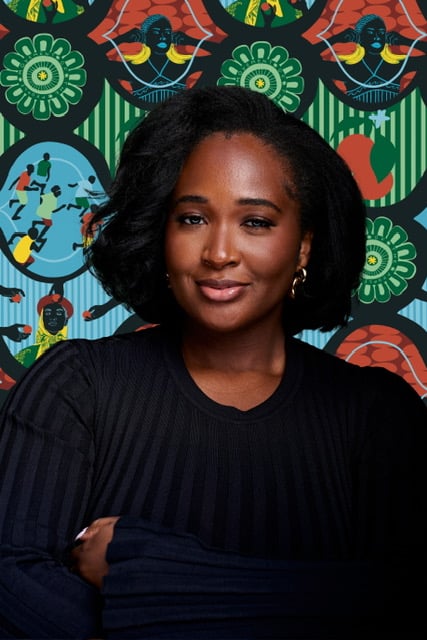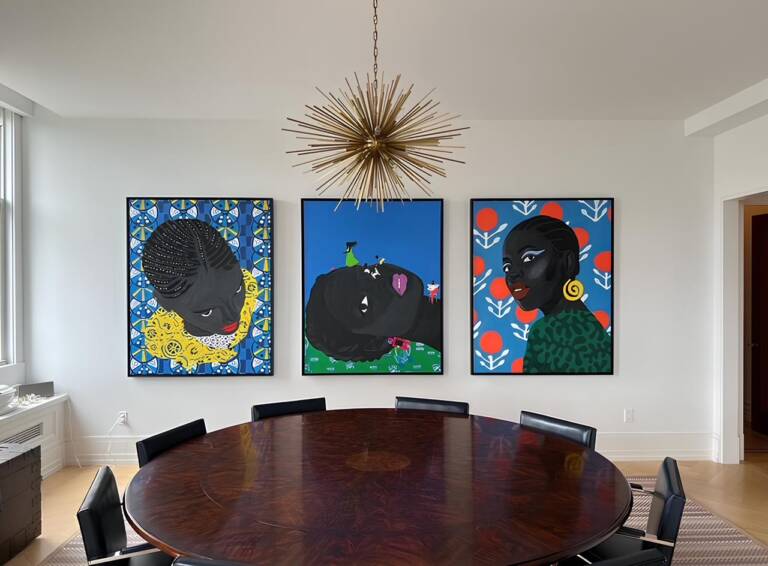

In Uzo Njoku’s world, colour is an anchor, a memory, a rhythm carried from lived on streets and global canvases. The Nigerian-American artist’s works, whether sprawling across a wall or wrapped around a body, translate fleeting surroundings into something enduring, revealing the pattern and rhythm in art that holds both place and spirit. From early recollections of a Nigerian household alive with pride, to New York’s relentless churn of opportunity and reinvention, her practice is a negotiation between roots and routes. We caught up with the artist to talk about the alchemy of colour, the cities that shape her, and how storytelling unfolds when a painting begins to breathe.
hube: Growing up in Lagos, a city rich with rhythm and visual culture, how did your early environment shape not just your aesthetic, but your relationship to storytelling through art? And now that you’re based elsewhere, how does that influence remain, consciously or subconsciously, in your practice?
Uzo Njoku: I wouldn’t say I grew up in Lagos, since I moved to America when I was seven. But what kept me connected to those early memories and to my culture was the way my parents carried their Nigerian identity with pride. As a child, I saw many immigrant kids teased or bullied for being African, but in my household there was never shame; instead, there was a constant reinforcement of who we were. That foundation shaped the way I approach storytelling through art: with a strong sense of where I come from, even when I’m working in other contexts. Over the past two decades, watching Nigerians rise on the global stage in art, music, and fashion has been incredibly affirming. It reminds me that my work, no matter where it’s made, is part of a much larger cultural narrative. Even now, living outside Nigeria, that influence shows up in my practice; sometimes consciously, in the patterns and palettes I choose, and sometimes subconsciously, in the rhythms, confidence, and spirit that underlie the work.
h: You studied Studio Art in Virginia. What led you to eventually settle in New York? You studied Studio Art in Virginia and now live in New York. What drew you to NY, and how has it challenged or expanded your identity as an artist?
UZ: After college, I found myself in Maryland without a clear plan for my future. I had applied to the New York Academy of Art, but at the time I wasn’t sure if I’d get in or even be able to afford it, so New York wasn’t on my mind. I worked as a nanny and at Michael’s Art & Craft, and since I couldn’t afford a studio, I began teaching myself digital art. When the pandemic hit and we went into lockdown, I started creating memes and artwork that went viral on social media. Riding that momentum, I released a collection of prints that instantly took off, which allowed me to expand, hire staff, and develop more products. Almost a year later, I was accepted into the New York Academy of Art on a full scholarship, and around the same time, galleries began inviting me to exhibit in New York. That’s what ultimately drew me here; both the opportunity to study formally and the chance to step fully into being a professional artist.
Living and working in New York has been both grounding and challenging. The city constantly pushes me to refine my voice while also reminding me of the importance of resilience. There’s an energy here that makes you bolder, but it also demands clarity; you have to know who you are as an artist, or you’ll get lost in the noise. For me, that challenge has expanded my identity, giving me the confidence to balance both my fine art practice and my role as a creative entrepreneur.

